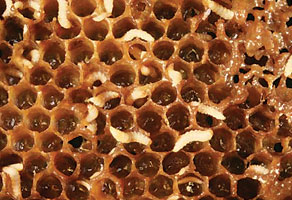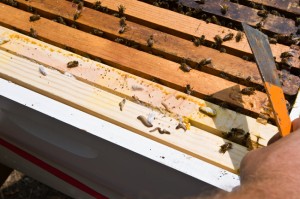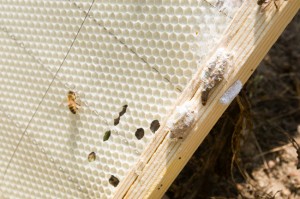Wild Times in September
Been really busy (bee-stuff and non-bee-stuff), so I have a bunch of updates regarding my Richmond, Virginia beekeeping adventures. To reduce boredom, I have tried to title each one separately below, so no one is forced to go through all of my dribble for the topic that really interests them!
Successful Swarm Trap!
This is hot on my mind and I couldn’t wait to post about it later. Anyone that has had the patience to actually read through my adventures for awhile knows that I put out swarm traps in the Spring. These are effectively homemade boxes the size of a Nuc that are screwed together tight and hang on a tree (some 8′ off of the ground.) In them, I put 1 frame of drawn wax (I use my old wax) and 4 or 5 frames of foundation (they were supposed to only hold a max of 5 frames, but my carpentry skills are nothing to write home about…)
In late March, I try to get my traps out within a quarter mile of my biggest outyards or known bee trees. The drawn wax is supposed to entice them and I put a drop of queen juice (simply a film canister with rubbing alcohol and the dead queens that I cull out of weak hives during the year.) By the end of June, I try to pull them to save any drawn wax that I can (sometimes the wax moths get in it and sometimes they don’t.) It’s not a loss, as the frames are my oldest frames that I culled from my hives, but I want to save the for the next year if I can.
Of the 6 that I put out this past April, I couldn’t get one of them (or, I wouldn’t) because it was covered in a thick patch of poison ivy that had grown up the tree (didn’t see that bit of nastiness when I put the thing up, because the leaves hadn’t come out!) I figured I’d either wait until Winter or get my pop to get it for me sometime (he’s immune to the ivy’s). With so little success, I had decided to start Nuc’s in each of my traps in the Spring of 2012 to get some good bee scent in them (and thus be more enticing to swarms.)
Well, the real point of this is that I went by that loner today (while doing some last minute checks on the hives) and found it FULL of bees! Ha! Success at last! I have no idea when the swarm came into the trap (well, I know it was after late June, when I last looked at it), so it will be interesting to see what they look like when I put them in a Nuc on Sunday. As long as the queen is laying well (and I’ll probably let them live even if she isn’t, as an experiment), they are golden. I have a ton of deep frames of honey to give them for the Winter (pollen is another subject – I do not have a lot of that to spare, so I hope they at least have that stored in the trap.)
Catching this one swarm has me pumped to build more of my traps this Winter!
July Nuc’s
Once July came around, I stopped selling Nuc’s (with the exception of one to an ERBA member who was interested in trying out a late Nuc – they are experienced beekeepers, so I sold it to them for a slight discount, even though I typically refuse to do so.) Most folks have always said that a July Nuc has next to no chance of growing to a full hive (and I have tended to believe them, because July and August are nightmares in central Virginia.)
This year, I purposefully tried to build up five early July Nuc’s using my simple techniques. One year does not a pattern make, but I was encourages. Each Nuc was fed with boardman feeders until they filled out their five frames fully. I then moved them to full deeps and dropped Maxant top feeders on them (I think this is the real key.) These feeders were easy to check and fill (pop the top, pour in the syrup) and I kept meticulous records of how much they got and how long it took them to eat it up – no hive went more then a day without syrup. These feeders can take nearly 3 gallons of feed, which makes it real easy.
Once they had drawn out at least 8 frames, they received a Medium of foundation, again with the feeder on top. Once they filled out 70% of the Medium, I moved them to an outyard. Of the 5 hives, 4 became full hives and were moved out before September 1. I would argue that the one that didn’t make it suffered from some bee problem (it may have been one of the paralysis viruses – the bees would flop out on the ground and not fly, or fly erratically at times.) They did not act right from nearly the start.
In conclusion, I think you can definitely build up a hive from a July Nuc (of course, I can only REALLY say this with confidence once I see them make it through the Winter.) I think the key is moving the big hives out of your Nuc yard once they fill out and using the top feeders (keeping them on syrup 24/7).
Irene Survivors
Irene gave me several hives, thanks to all of the trees that went down with bees in them in the Richmond area. I’m not happy that the trees went down, but (glass is half full) I am glad folks called me to cut them out. My last cut out was about 10 days after the hurricane. The tree had landed on its side and the comb had smooshed together. By the time that I got to them, most of the comb (literally 90% of it) was full of SHB and wax moth. I was surprised the bees had not absconded (the two hives I went to get the day before had both absconded because of the smashed wax.) I cut them out and hived them in less then 30 minutes, leaving about 4 lbs of bees with no resources (I mean NONE). The comb that I did get was empty – no brood, no honey, no pollen – they had been mostly robbed out after the tree crashed.
I took the poor lot home with me and gave them 3 frames of resources from my stash and left them alone for a week. I wasn’t sure if I had the queen (and figured she had died in the storm, which is why the bees had not absconded.) Amazingly enough, I spotted the little wench on the first inspection. She had actually laid eggs in every single open cell (I honestly do not know how the bees will be able to cover all of that brood, but will see how they did on Sunday.) I have given them two more frames of resources (deep frames partially full of nectar/honey with some pollen) and will be interested to see if they make it through the Winter.
Winterizing
I have Winterized all hives in Charles City County now, which comes to 23 hives. All have entrance reducers, a shim for ventilation and confirmed queens. I did not have to reverse any of them (all queens either were laying in the bottom deep or had just started to move down over the last month). I leveled several (some had definitely gotten off-kilter during the year) and checked stores one last time (well, I’m sure I’ll be back in each of them, to some degree, in October). That leaves 6 more hives in Henrico to do over the weekend and it’s Winter, here I come! My backyard is a mix of Nucs for overwintering, Nucs from swarms, Nucs from cut-outs and one full hive that I kept for fun (I’ll move her out next Spring, but I like to see what the bees are doing during the Winter when I go out into the yard.) It really comes down to 1 full hive, 1 partial hive (from the August cut-out) and 3 Nuc’s. I am only counting the 1 full hive for my Winter metrics (so, how many of 30 will I lose?)
Fall Honey Crop
I took a little under 10 gallons of honey off of the hives earlier this month! I’m sure this isn’t much to most beekeepers, but I am excited! For the first year that I actually took honey, I took between 20 and 25 gallons of honey! Wow! There still a fair amount left on the hives, but I won’t extract that. I have each of the ‘bank’ hives noted so that I can steal their resources come Jan/Feb in case my home yard experiments are struggling. All in all, I am feeling pretty good about the future…
Nuc List
My Nuc list is filling up, which is very cool. Folks are starting to see the value in local bees that are not medicated. My primary goal now is to make sure that I have enough Nuc’s built to produce the numbers that I need. I do not foresee a problem, but I like to be over-prepared. There is still a good bit of prime painting weather left in the season!
Master Beekeeper?
I took the Certified Level test last weekend. I must say that I am not confident about it, but am hopeful. The test wasn’t extremely hard, but some of the virus/disease questions were nothing more then educated guesses for me. Plus, they had an entire part based on chemicals, which I do not use. Fortunately, I had studied up on it. I am confident that I DID pass the field test, but will not know about the written test for some time.
So, that’s it. Another month gone and another month closer to Winter. Many more adventures to be had.



